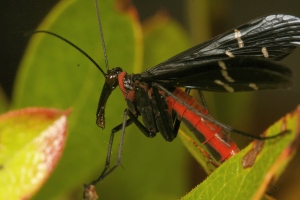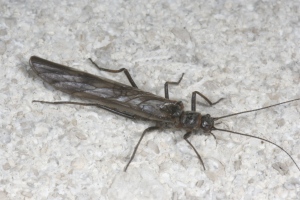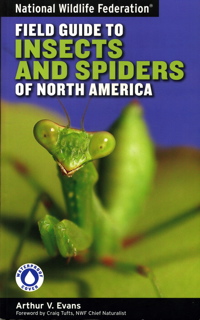By Arthur V. Evans
Last month, while attending a meeting of the Bull Run Mountains Conservancy held in The Plains, Virginia, I was approached by several members who wanted to know about a stink bug that had invaded their homes by the dozens or hundreds in the fall. At first I thought they were referring to a species of bark stink bug, Brochymena, which sometimes enters homes by hiding under the bark of firewood hauled inside for the fireplace. Just as I was going into my spiel about sending me a photograph or a specimen for identification, someone said, “Look! There’s one!”

The brown marmorated stink bug, Halymorpha halys Stål, is steadily expanding its range across North America.
Sure enough, a robust gray stink bug was slowly making its way up the wall toward a window through which the day’s last rays of sunlight were shining. Judging from its distinctive markings, I knew that it was not a species of Brochymena and wondered if it might be the brown marmorated stink bug (BMSB), Halymorpha halys Stål. My suspicions were soon confirmed.
This uninvited insect from Asia has proven to be quite a nuisance to many homeowners in northeastern United States for the past several winters. They are much more likely to take up residence inside buildings than either of their native look-alikes, Brochymena and Euschistus.
BMSB was first reported from Allentown, Pennsylvania in 2001, but it turns out that the species has been in that area since at least 1996. The very first individuals probably arrived in America as stowaways, possibly as eggs, on packing crates most likely shipped from China or Japan. Since then, they have spread throughout Connecticut, Maryland, New Jersey, New York, Pennsylvania, Virginia, and West Virginia. As of 2004, an isolated population has become established in Oregon.
Like other stink bugs in the family Pentatomidae, BMSB are “shield-shaped” in outline. They are about 17 mm in length and are nearly as wide as they are long. Unlike similar species of native stink bugs, BMSB has white bands on the antennae and dark bands along the edges of the abdomen surrounding the wings. The head and pronotum (upper surface of the mid section, or first thoracic segment) have patches of small, round coppery or metallic bluish pits. The glands that put the stink in these and other pentatomids are located on the underside of the thorax and upper surface of the abdomen.
Brown marmorated stink bugs probably produce a single generation per year in America, but records from the sub-tropical regions of China indicate that there are 4-6 generations annually. Local populations of adults emerge from their winter hideaways in early June and begin mating and laying eggs almost immediately. The small black and red larvae (nymphs) soon hatch and molt five times during the months of July and August. Adults appear in mid August and begin seeking overwintering sites by mid September as the evenings start to become cooler.
To escape the cold, BMSB enter homes, out buildings, office buildings, and other structures by crawling under siding and shingles, around door and window frames, and into crawl spaces and attics. Once inside, they will settle in and become inactive for short periods. However, reinvigorated by the warmth of home heating systems, they are driven to crawl over walls and furniture, or fly clumsily to lights and windows.
As they bumble about, BMSB leave their odor on everything they land and crawl on. The accumulation of this odor at a good hibernation site serves as a powerful chemical beacon that attracts their brethren to the same location year after year.
The best way to keep BMSB out of homes and other structures requires preventative measures to be taken during the summer, after the bugs have already left, to prevent a re-infestation in the fall. Seal cracks and spaces around doors, windows, vents, utility access points, siding, trim, fascia boards, and chimneys. Caulk is handy for small cracks, but wire mesh and screens may be required when dealing with larger spaces associated with attics and foundation vents.
The good news is that once inside your home, BMSB will not bite you or your pets, spread disease, nor lay their eggs. Their piercing-sucking mouthparts are adapted for drawing sap from plants, not damaging furniture, clothing, or other household items.
Using insecticides on BMSB indoors is not particularly effective. Crushing them or sucking them up with a vacuum cleaner causes them to release their noxious odors that may persist in a room or on cleaning implements for sometime. Any disturbance perceived by the bugs as a threat will cause them to stink as a defensive measure. The best thing to do is to simply let them walk on a piece of paper and take them directly outside.
What is being done about BMSB nuisance in America? Since they have yet to become serious agricultural pests here in the States, there is little incentive for chemical companies to develop pesticides to combat them. Pesticides of any kind are incredibly expensive to bring to market and the number of homeowners plagued by home invasions of these bugs will never support the company’s efforts to recoup their investment, much less generate a profit.
But all is not lost. Researchers are learning everything they can about BMSB so that they can identify the weak links in their life cycle and exploit them to affect some level of control. Select BMSB genes and proteins are being sought for the possible development of genetically modified crops that will help suppress their numbers. There is also the possibility of using parasitic insects that will attack stink bugs during egg stage, not only to lessen their potentially harmful impact on crops such as soybeans, cotton, and corn, but also to reduce the numbers of individuals seeking shelter for the winter.
One of the more promising avenues of research involves the synthesis of attractant chemicals, or pheromones, to use in stink bug traps. Although BMSB attractant pheromone is currently unknown, scientists have discovered that they are attracted to the pheromones produced by the male of another species of stink bug native to Japan, Plautia stali Scott. Traps in America baited with this pheromone not only attract BMSB, but also some native species of stink bugs and a tachinid fly, Trichopodes pennipes, that parasitizes native stink bugs.
Why would these stink bugs and one of their natural enemies be attracted to the pheromone of another species of stink bug? Research on other stink bugs species suggests that some use the pheromones of stink bug species other than their own in an effort to locate better feeding sites. Further, this chemically induced aggregation of different species of stink bugs may serve as a defensive strategy known as the “selfish-herd effect.” As the herd, or aggregation, grows individual stink bugs are increasingly less likely to be selected by a parasitic fly that, not so coincidentally, uses the very same pheromone to locate its victims. The discovery of the attractiveness of this pheromone offers up a potentially useful tool for monitoring and managing BMSB in America.
BMSB is steadily expanding its range across North America. Although clearly annoying to homeowners, the degree to which this species will become an agricultural pest in America remains unclear, especially as it moves south into warmer climates. Within their native range of China, Japan, Korea and Taiwan BMSB is most certainly an agricultural pest, attacking soybeans, apples, peaches, figs, mulberries, citrus, persimmons, and a variety of ornamental plants.
For now, all we can do is batten down the hatches and hope that science will come to the rescue.
© 2010, A.V. Evans





 The mourning scorpionfly, Panorpa lugubris, is easily distinguished from all other North American Panorpa by its mostly black wings sprinkled with a few white spots. Its body is also black, but with bright and contrasting patches of reddish orange. This species inhabits both the Atlantic and Gulf coastal plains, from Virginia south through the Carolinas, Georgia, and west across the Florida panhandle to Louisiana.
The mourning scorpionfly, Panorpa lugubris, is easily distinguished from all other North American Panorpa by its mostly black wings sprinkled with a few white spots. Its body is also black, but with bright and contrasting patches of reddish orange. This species inhabits both the Atlantic and Gulf coastal plains, from Virginia south through the Carolinas, Georgia, and west across the Florida panhandle to Louisiana.
 For me, the sudden appearance of these hardy insects serves as an annual reminder that winter is almost over and spring is on the way. This is welcome news to entomophiles living in the frosty and leafless eastern United States!
For me, the sudden appearance of these hardy insects serves as an annual reminder that winter is almost over and spring is on the way. This is welcome news to entomophiles living in the frosty and leafless eastern United States!


